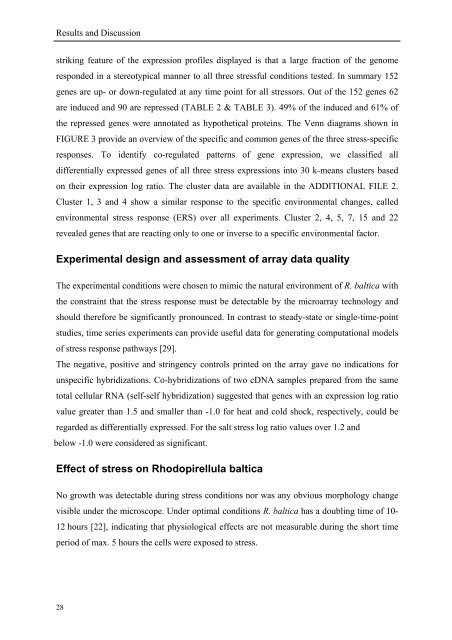a Whole Genome Array Approach - Jacobs University
a Whole Genome Array Approach - Jacobs University
a Whole Genome Array Approach - Jacobs University
Create successful ePaper yourself
Turn your PDF publications into a flip-book with our unique Google optimized e-Paper software.
Results and Discussion<br />
striking feature of the expression profiles displayed is that a large fraction of the genome<br />
responded in a stereotypical manner to all three stressful conditions tested. In summary 152<br />
genes are up- or down-regulated at any time point for all stressors. Out of the 152 genes 62<br />
are induced and 90 are repressed (TABLE 2 & TABLE 3). 49% of the induced and 61% of<br />
the repressed genes were annotated as hypothetical proteins. The Venn diagrams shown in<br />
FIGURE 3 provide an overview of the specific and common genes of the three stress-specific<br />
responses. To identify co-regulated patterns of gene expression, we classified all<br />
differentially expressed genes of all three stress expressions into 30 k-means clusters based<br />
on their expression log ratio. The cluster data are available in the ADDITIONAL FILE 2.<br />
Cluster 1, 3 and 4 show a similar response to the specific environmental changes, called<br />
environmental stress response (ERS) over all experiments. Cluster 2, 4, 5, 7, 15 and 22<br />
revealed genes that are reacting only to one or inverse to a specific environmental factor.<br />
Experimental design and assessment of array data quality<br />
The experimental conditions were chosen to mimic the natural environment of R. baltica with<br />
the constraint that the stress response must be detectable by the microarray technology and<br />
should therefore be significantly pronounced. In contrast to steady-state or single-time-point<br />
studies, time series experiments can provide useful data for generating computational models<br />
of stress response pathways [29].<br />
The negative, positive and stringency controls printed on the array gave no indications for<br />
unspecific hybridizations. Co-hybridizations of two cDNA samples prepared from the same<br />
total cellular RNA (self-self hybridization) suggested that genes with an expression log ratio<br />
value greater than 1.5 and smaller than -1.0 for heat and cold shock, respectively, could be<br />
regarded as differentially expressed. For the salt stress log ratio values over 1.2 and<br />
below -1.0 were considered as significant.<br />
Effect of stress on Rhodopirellula baltica<br />
No growth was detectable during stress conditions nor was any obvious morphology change<br />
visible under the microscope. Under optimal conditions R. baltica has a doubling time of 10-<br />
12 hours [22], indicating that physiological effects are not measurable during the short time<br />
period of max. 5 hours the cells were exposed to stress.<br />
28

















